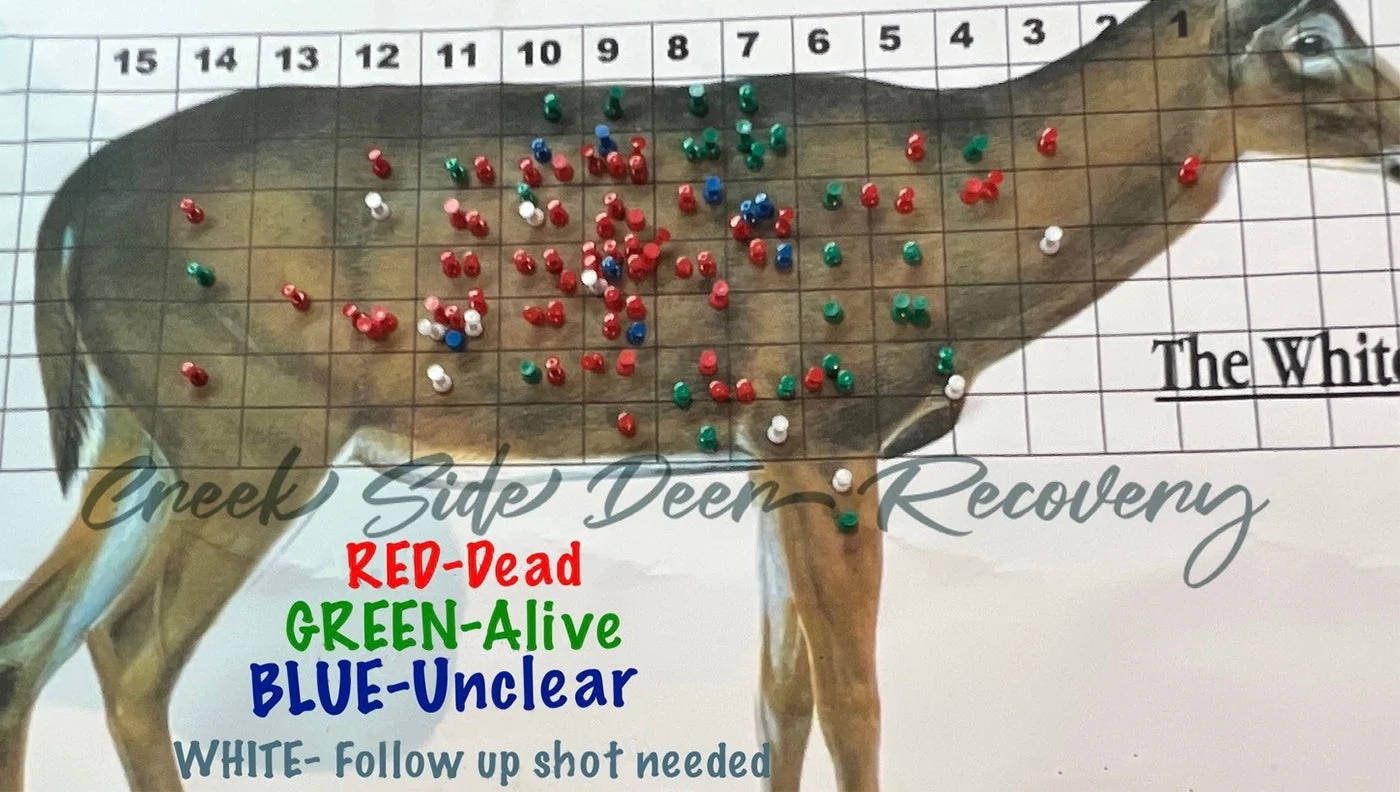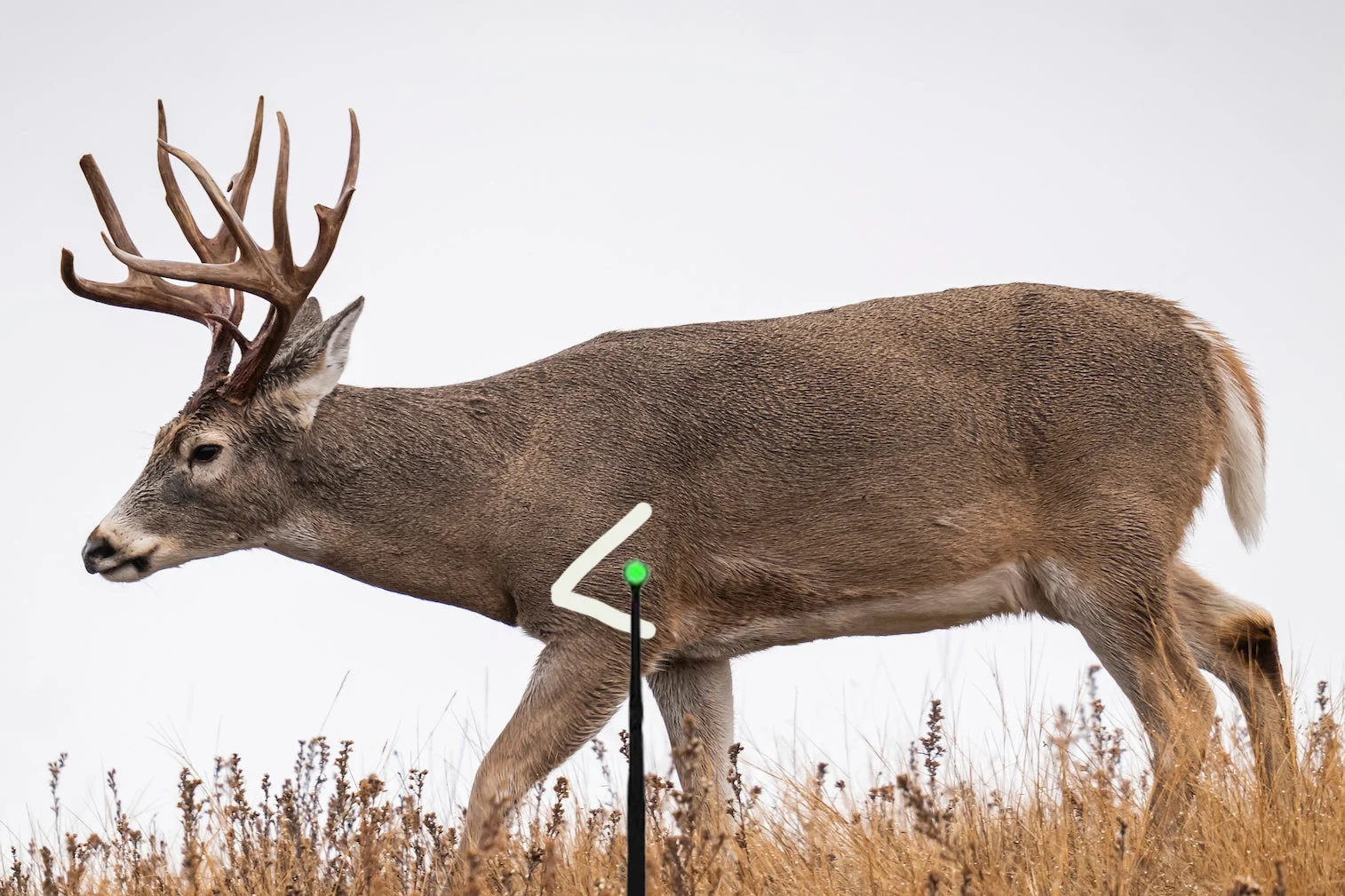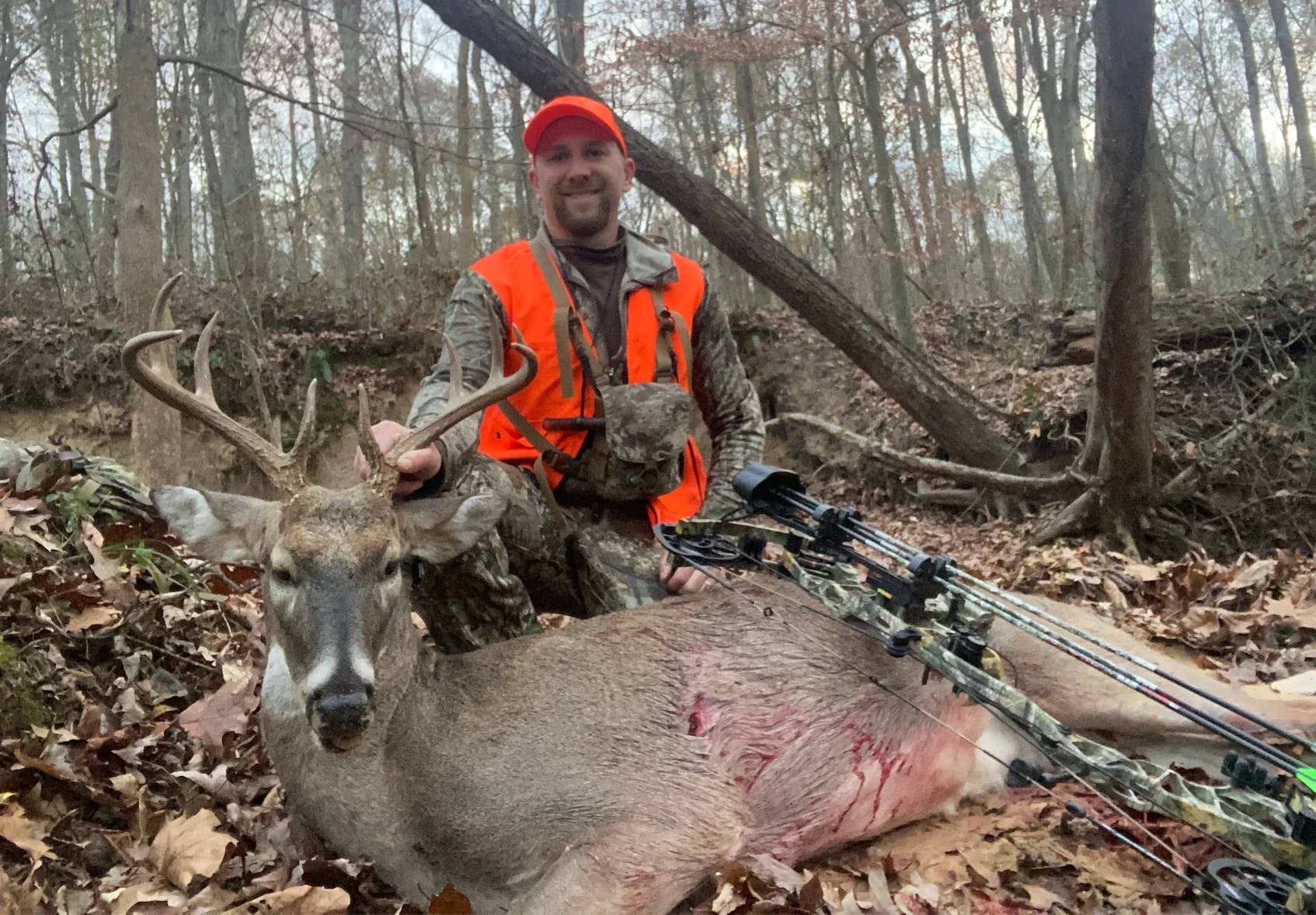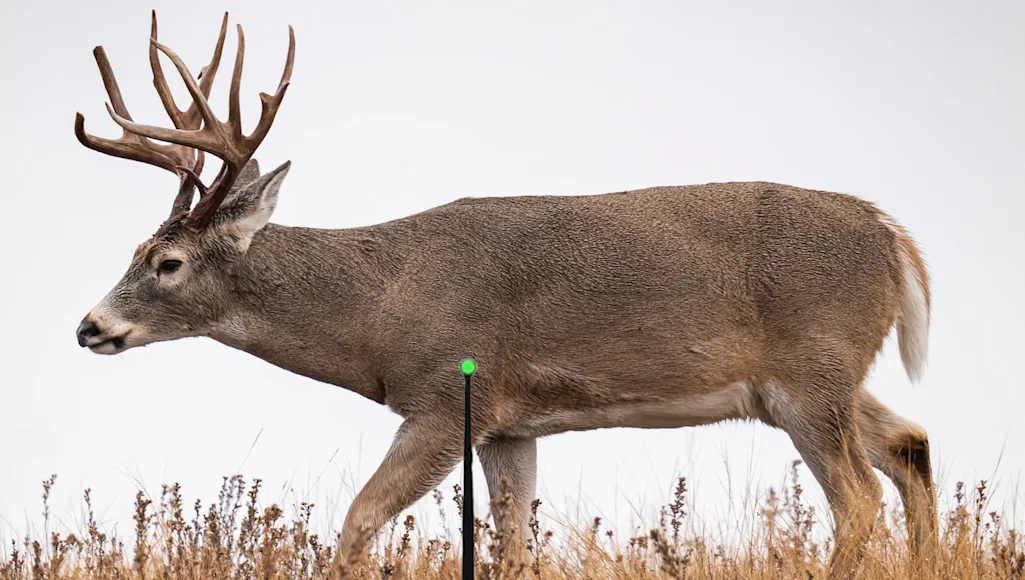We bowhunters need to stick together, especially when it comes to ostracizing gut-shooters. When this story
was posted a little more than a week ago, showing a shot-placement chart created by a professional deer tracker and claiming to prove why bowhunters should avoid the trendy advice of aiming right at a whitetail deer’s shoulder, it riled a bunch of folks up, me included. I was asked to write a rebuttal and was so fired up about it, it took me about five days longer than it should have. What can I tell you? I have a lot to say on the subject.
Call me trendy if you want (it would be a first), but I’m one of those “new-age” kids who likes heavy-ish arrows, fixed-blade broadheads, and aiming at the “Vital V.” In my experience, it’s the deadliest place to shoot a deer (and most other hoofed critters). That experience includes 26 seasons of bowhunting whitetails in multiple states, plus several years’ worth of outfitting, testing broadheads for Field & Stream, and running a tracking dog of my own.
Related: Where to Aim at a Deer with a Rifle
Before I start my argument, I want to spend some time specifically bashing F&S whitetails editor Scott Bestul, the author of the other story. He’s been bowhunting
for 44 seasons, four years longer than I’ve been alive, but obviously not long enough to know where to shoot at a deer. For what it’s worth, he says summer sausage is better than jerky, too, and I don’t think you can trust anyone who believes that.
I’m kidding, of course. Scott’s a good friend of mine with a good sense of humor and a thick skin. He’s also arrowed more Boone & Crockett bucks
than I have and probably more than you have, too. He killed two of those bucks with a recurve. In fact, Bestul has shot so many deer and followed so many blood trails in his four and a half decades of experience that he’s pretty convinced that shooting a deer a couple inches behind the shoulder kills them dead as hell. He’s also seen, first-hand, arrows that were stopped by the heavy bones of the shoulder, and so he’d personally rather not aim there.
Who am I to argue with that? A guy who gets paid for it, that’s who. So, let’s dig in.
What the Tracker’s Chart Shows—and What it Doesn’t

For reference, here is the chart put together by professional tracker, Joseph Tenney. Creek Side Deer Recover
The chart in the previous article was at the heart of the controversy, and not surprisingly. There’s a lot of context missing. The chart really only proves one thing: That liver and gut-shot deer are easy for a tracking dog to find. Anyone with tracking-dog experience knows that. Deer hit in those places almost always die, but it can take hours or days, and they don’t always leave much blood behind. Those hits comprise a large percentage of the calls for tracking dogs.
Meanwhile, good trackers stay busy and try only to put their dogs on tracks with the best odds of recovery. Joseph Tenney—the tracker who put the chart together and who Scott interviewed—told me that he had 120 calls in two days last season. He meant for the chart to be a quick reference for other trackers, but it got a lot of attention from bowhunters on social media too.
The 110 or so pins on the chart represent hits where a tracking dog was used. The chart doesn’t show hits where a tracking dog wasn’t called, and it was never meant to illustrate ideal shot placement. You don’t see many pins in the lower quadrants of columns 6 and 7—the Vital V—because the hunters who hit that spot are skinning deer and celebrating, not looking for tracking dogs. “There are no pins in that section because that’s where you need to hit,” Tenney says. “It’s where I aim, low and at the heart when the leg is forward.”
Most of the shoulder hits Tenney is talking about—and indeed almost all of the ones represented with green pins on the chart—are the result of arrows placed either too high (which hits the scapula, or shoulder blade) or too far forward (which hits the humerus, the heavy bone of the upper leg). Could those hits have been fatal with better equipment? Perhaps, but we really don’t know what equipment was used. So, more on that in a bit.
Shot Angles And Unrecovered Deer
Multiple people with the Ashby Bowhunting Foundation
were vocal opponents of last week’s story, and they pointed to two glaring omissions with the chart. First was no mention of shot angles. Few shots taken at whitetails are actually perfectly broadside, and that’s why an understanding of angles and anatomy is of fundamental importance to being an effective bowhunter. Trees stands add another element, too.
Another question that was widely posited was that if the green pins represent living deer, how did the trackers know exactly where they were hit? Things get fuzzy in the moment of truth, after all, when the adrenaline is pumping. I’ve had clients shoot a deer, watch the animal fall dead, and then in their excitement, lead me to the wrong ridge altogether. But Tenney told me that most of those green pins actually were verified, either confirmed on video (he says it’s crazy how many people are filming their hunts now), or by trail-camera photos after the fact. The truth is, wounded deer often do return and show you exactly what happened—something I’ve seen myself, and have always found interesting.
Is Missing Back Really Better Than Missing Forward?
My main objections to the previous article are, first, the chart itself, which without proper context, can be seen to suggest that gut-shots are just fine. (To be clear, Bestul never suggests aiming there or anywhere near there.) And second, a couple of the quotes in the story do seem to further this idea. One, when Tenney says, “Low is better than high, and back is better than forward.… Over 90 percent of paunch-hit deer are going to die, and if you handle things right—by waiting long enough before tracking—we’re going to find that deer.”
The second, from another tracker named Shon Butler, advises hunters to draw a line horizontally through the middle of the body, and then aim at that line, 3 to 4 inches back from the shoulder. He says, “If you hit that spot, you’ve got at least one lung. And if something goes wrong, there’s room for forgiveness and chances are high your shot will hit something vital.”
It worries me that, although this may not be what Butler meant, some people may take that to mean that it’s OK to hit a deer in the liver, because you can always find him with a dog. To me, that way of thinking is not okay. In my opinion, you should be totally focused on hitting the spot that’ll kill your deer the quickest, and not on what’ll happen if you miss.
Aim at the Vital V on Deer

The trailing edges of the scapula and humerus bones form a V just ahead of the shoulder crease that widely called the “Vital V.” John Hafner Photography
The deadliest place to hit a deer is in the forward section of the lungs, through the major pulmonary vessels and the top of the heart. Right through the Vital V, in other words. Hit that, and the deer will rarely make it out of sight. Is it a smaller target than the center of the rib cage? Yes, but it’s still 6 inches in diameter, give or take, and if you can’t hit that with a modern compound bow, you either need to practice more or keep your shots closer. A hit that’s a little back from the Vital V is still through both lungs—and, in fact, right through Scott’s preferred aiming point, just behind the shoulder crease. Dead deer, and a quick recovery.
You will hit bone if you’re a little high or a little forward, but if you don’t penetrate it, chances are high the deer survives. That’s not ideal, but it’s better than spoiled venison in my book. But even so, those bones aren’t that difficult to penetrate if you have the proper equipment. For proof of that, I spoke to Dr. Ed Ashby himself (who’s a hell of a nice guy, by the way).
“I took great exception to that article,” Ashby said. “We don’t advocate aiming right at the shoulder. We advocate aiming at the Vital-V area. Yeah, that puts you close to bones, but if you’re shooting the proper arrow setup and it hits bone, you should go right through it. One thing that got me was, after I read the first story on the Field & Stream page, I noticed another article right under it about rifle cartridge killing power (The Truth About Rifle Cartridge Killing Power
). The author of that said the number one factor to consider was the hunter’s shooting ability. The second factor was construction of the bullet. Too many people don’t look at the construction of their arrows.”
Ashby, a former PH in Africa, has tomes of research based on decades of experimentation with different broadhead styles and arrow configurations shot into different critters, particularly cape buffalo. He says those big animals are ideal for a testing medium because they have ribs that are wide, flat, and a minimum of a half-inch thick—comparable to the heaviest part of the scapula on a really big whitetail.
Ashby’s research has proven over and again that heavy arrows (650 grains+) with a high Front of Center (FOC) and cut-on-contact broadheads (particularly single-bevel models with a tanto-style point) penetrate best—and they don’t have to be moving all that fast to do it. Most of Ashby’s research was done with traditional equipment (and if you want to geek out on the reading, visit Ashbybowhunting.org and start with 12 Arrow Penetration Factors
under “Reports”).

Brantley shot this Tennessee buck with a quartering-away shot, and his arrow broke clean through the humerus bone on the far side. Will Brantley
In other words, you don’t need to be shooting a speed bow with extremely heavy draw weight to break shoulder bones. You do need to be shooting the right arrows. But what does that look like in the real world? Most real-world whitetail hunters aren’t using a 650-grain arrow tipped with a $30, 200-grain Ranch Fairy broadhead. Finished hunting arrows of around 400 grains tipped with 100-grain mechanicals are more the norm. But I think that’s where the average whitetail hunter could stand to be a little more open-minded, and, if they’re not going to go crazy-heavy, at least to look to a setup that’s somewhere in the middle.
My personal finished arrows are small-diameter, 350-spine carbon shafts with 50-grain outserts and 125-grain fixed-blade broadheads. They weigh just under 500 grains. I do prefer a speedier bow, but my specs are light, at 60 pounds with a 28-inch draw length. It shoots around 250 fps—too slow to brag about in the archery shop, but plenty flat-shooting enough for whitetails inside 40 yards.
Last fall, I killed a quartering-away buck in Tennessee at 25 yards, and centered the humerus on the exit, breaking it clean in half. The season before, I shot a Texas buck that was quartering sharply away, behind the last rib (dead center of column 12 on the chart). But the arrow exited the buck’s chest through the brisket and stuck in a mesquite tree. No tracking dog needed there.
That works for me. And also, jerky is way better than summer sausage.

